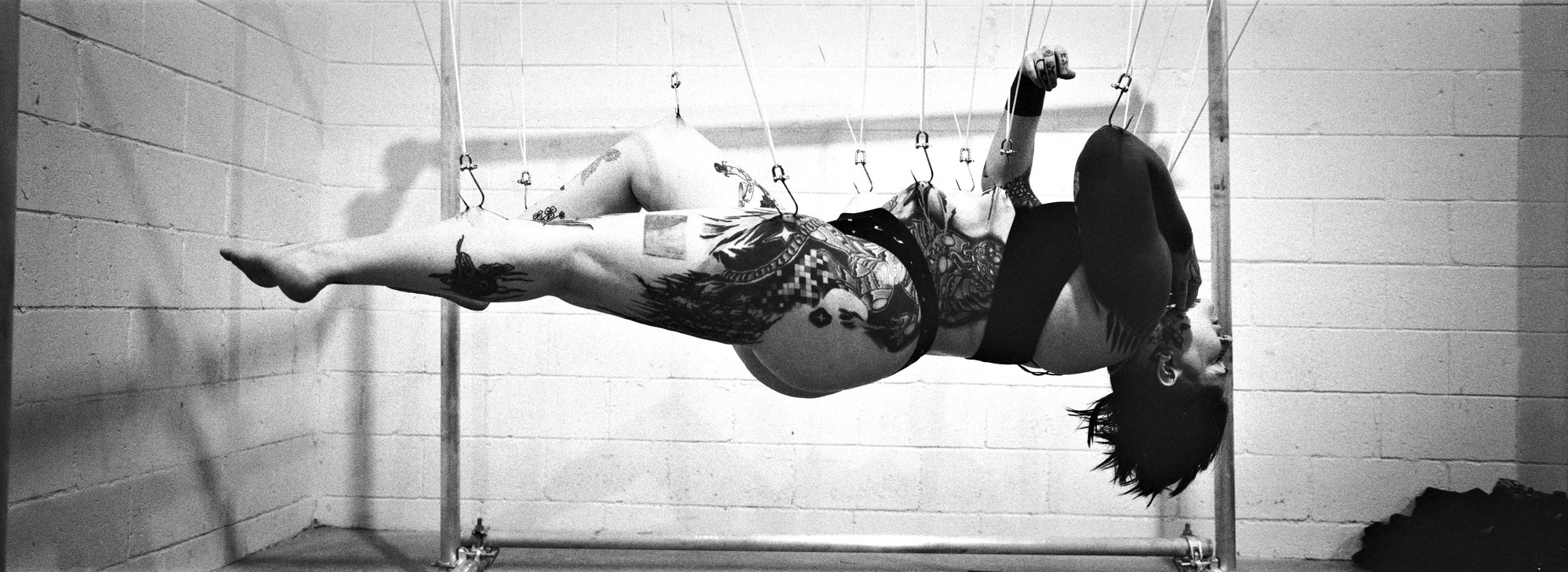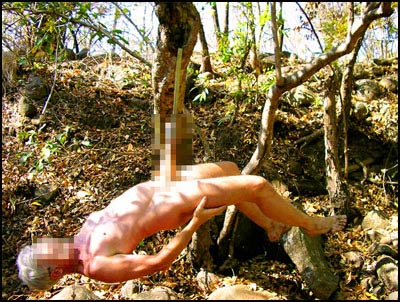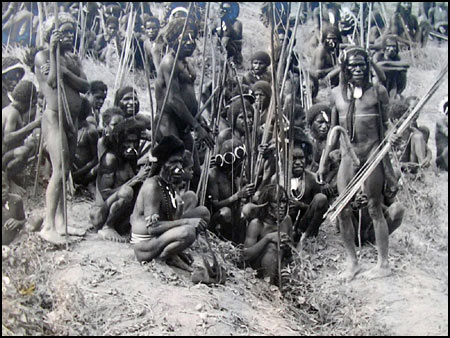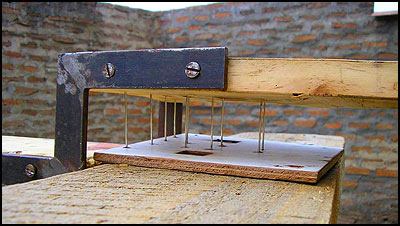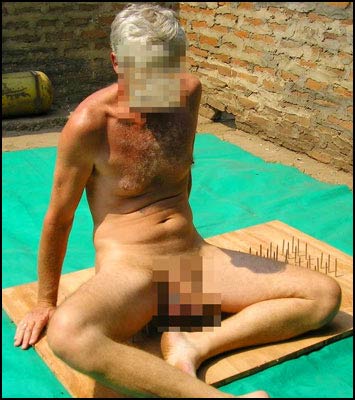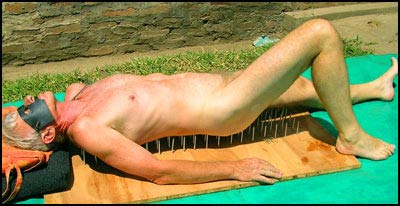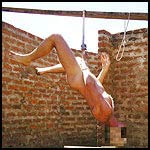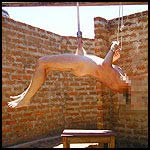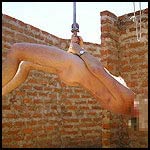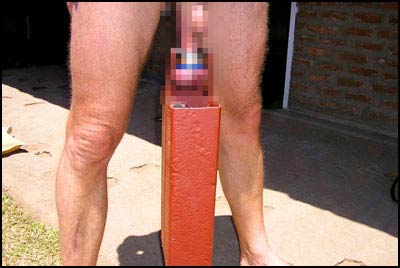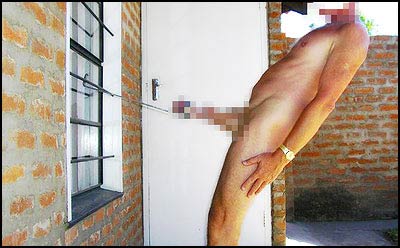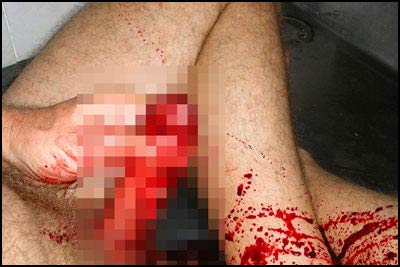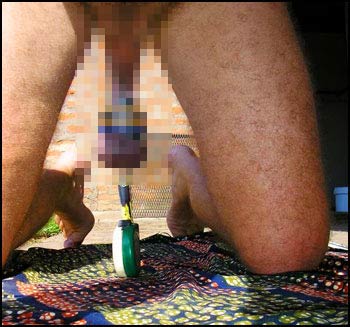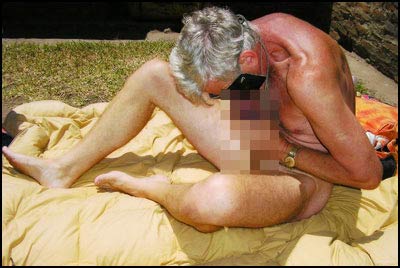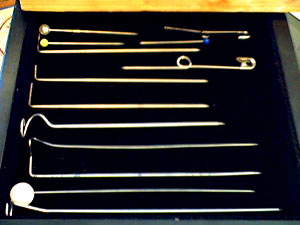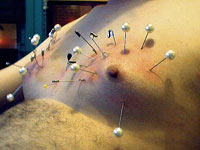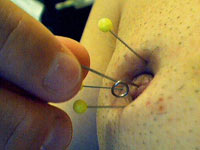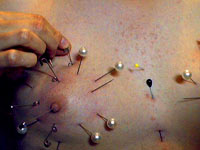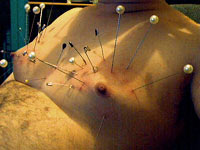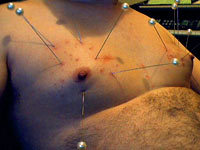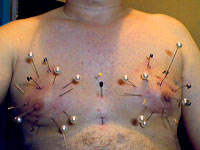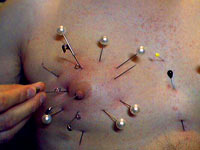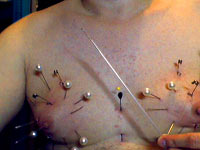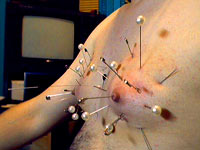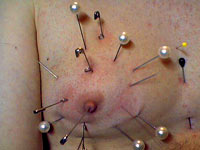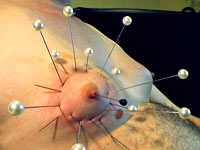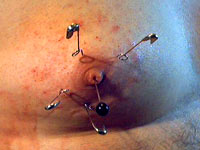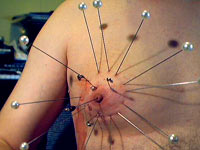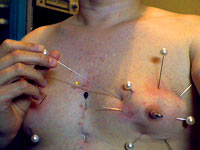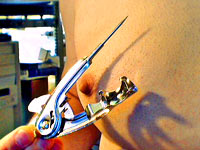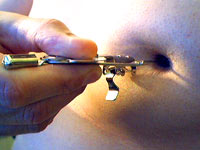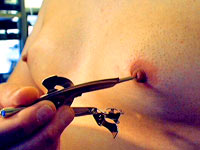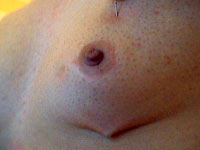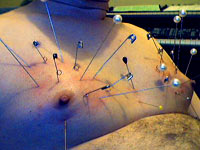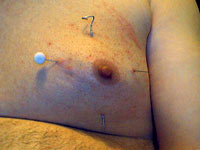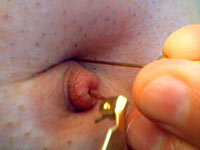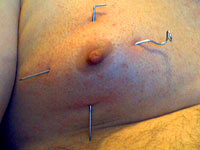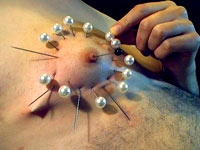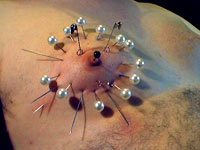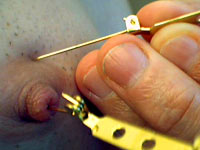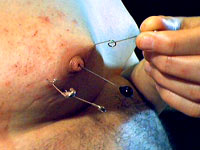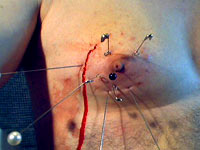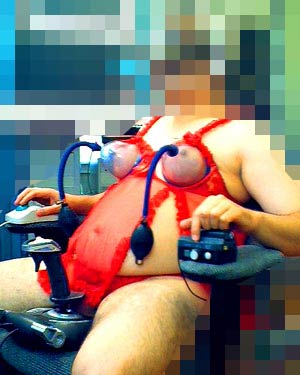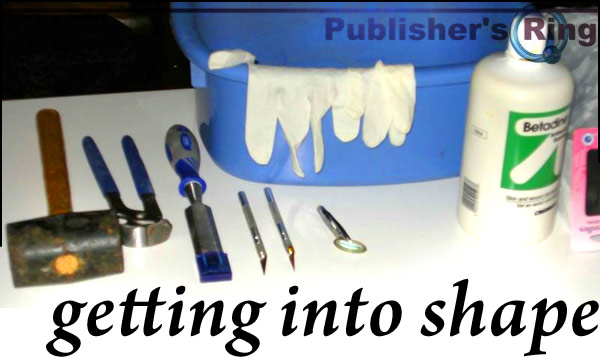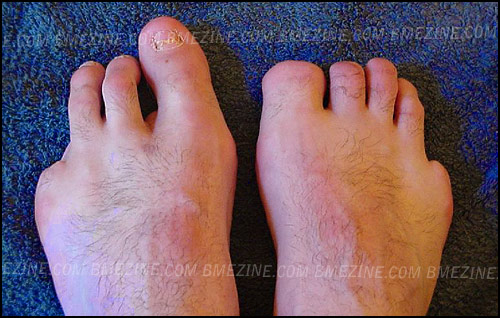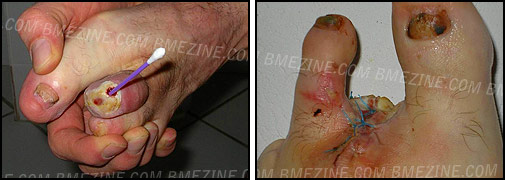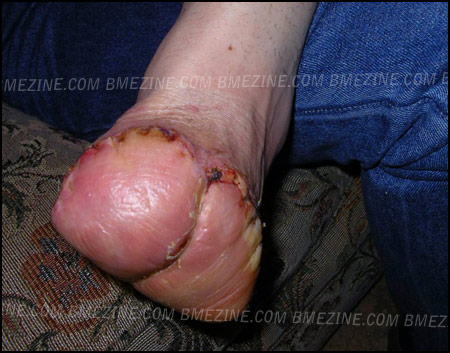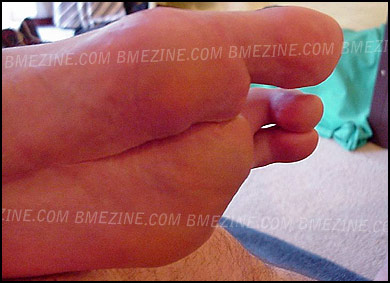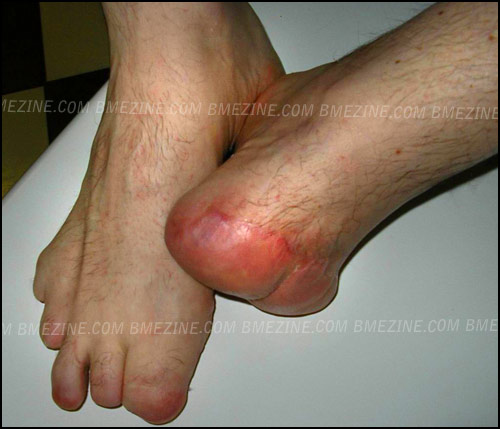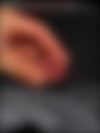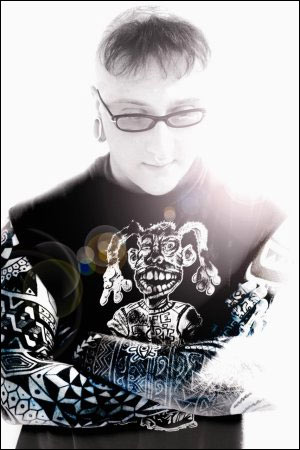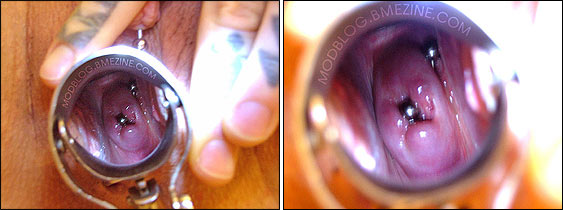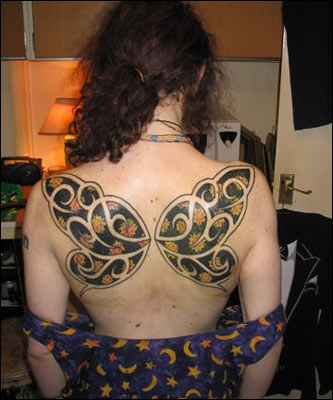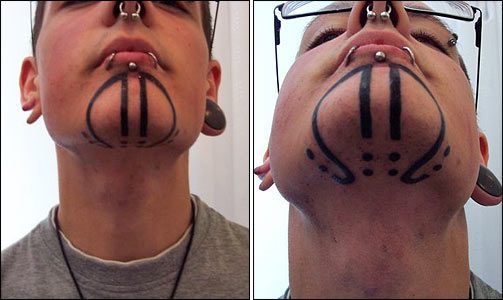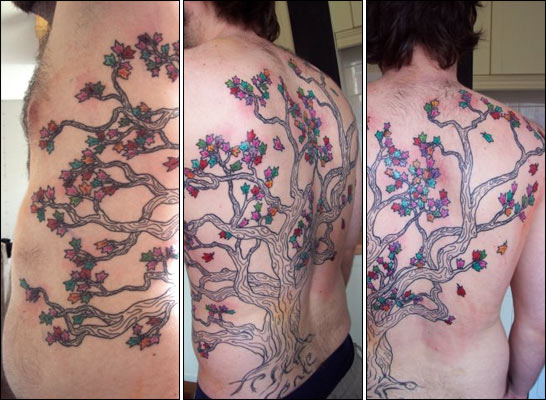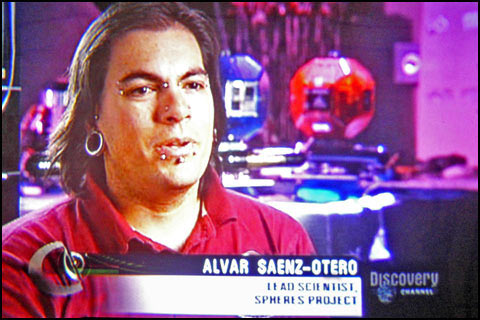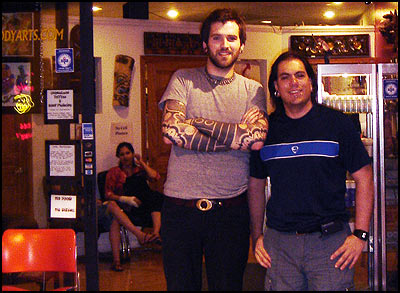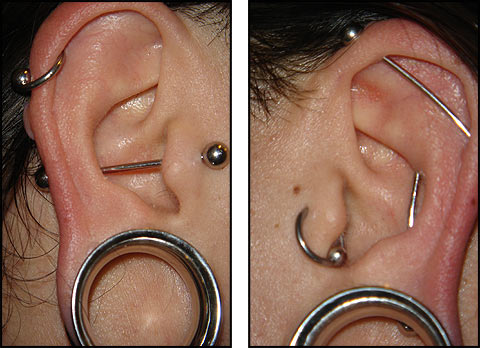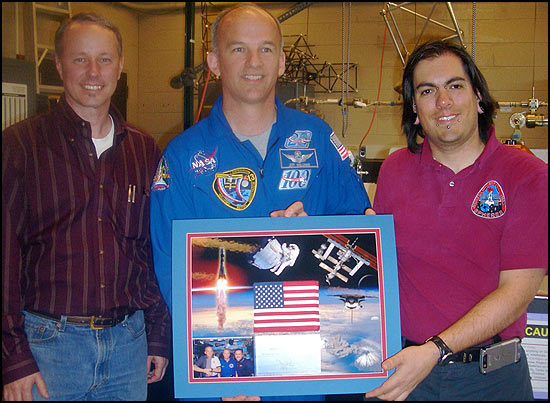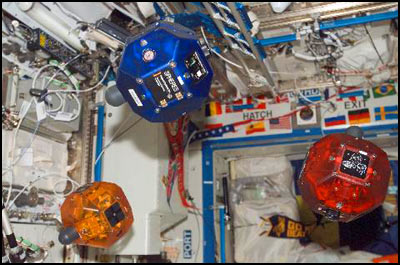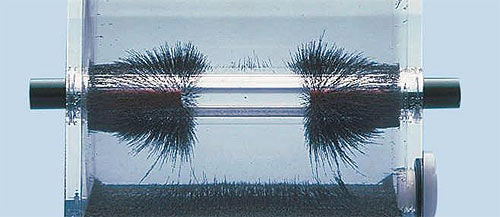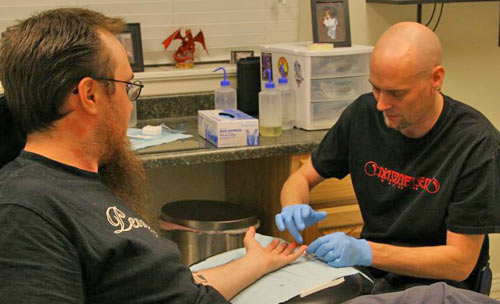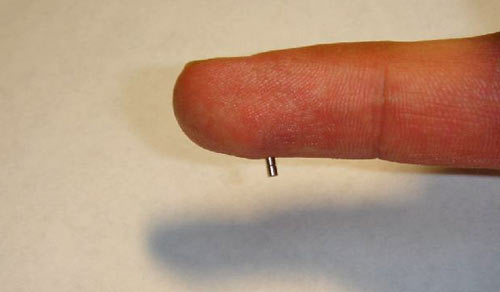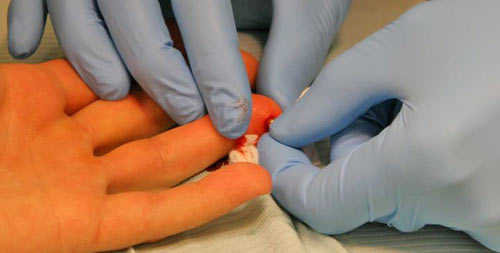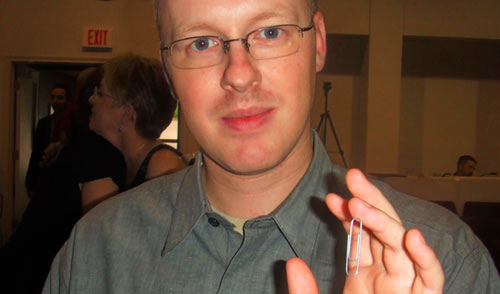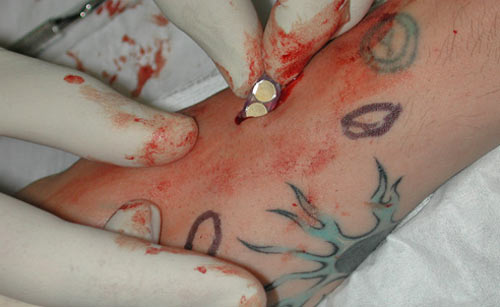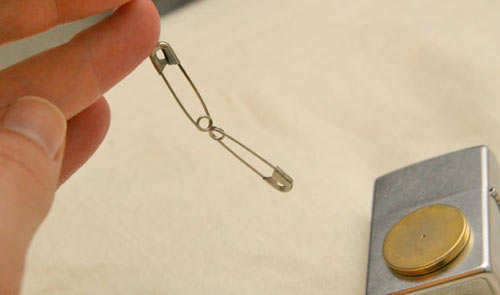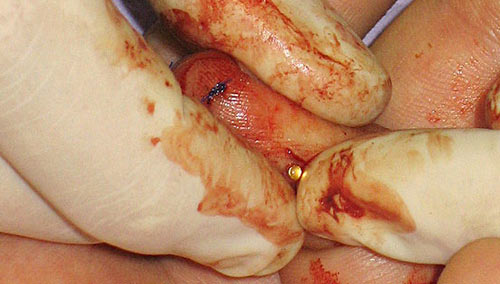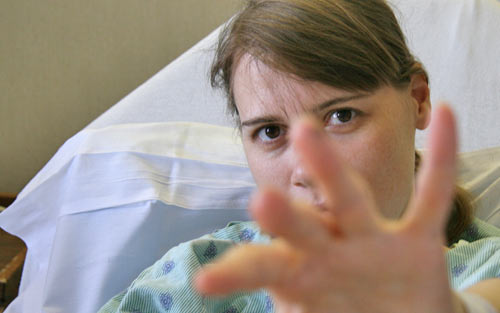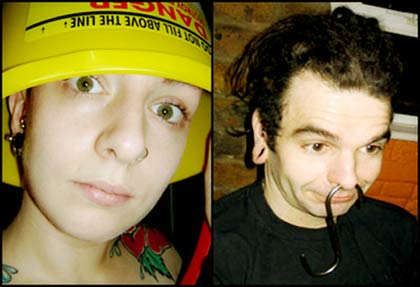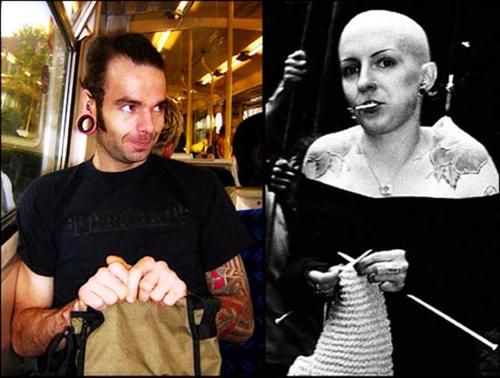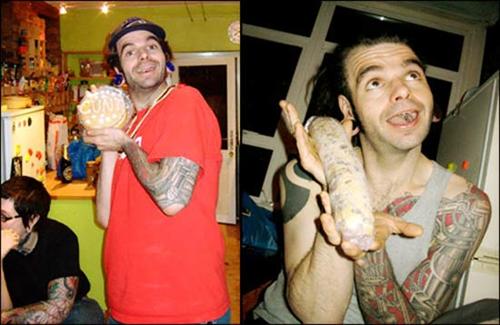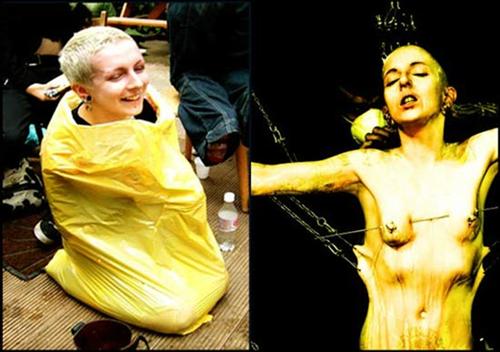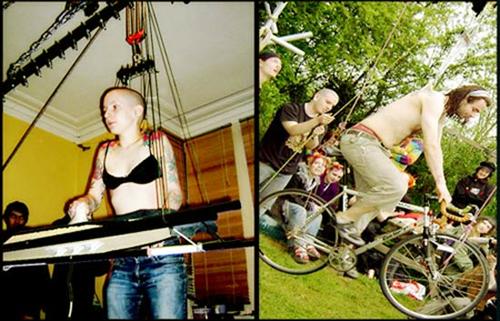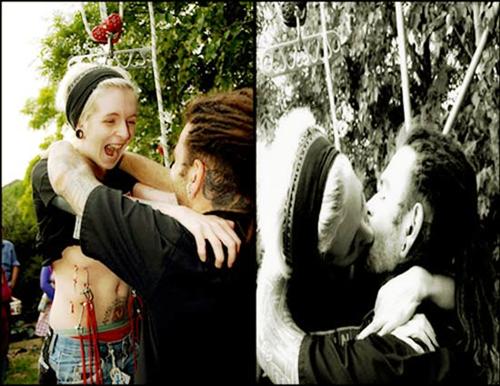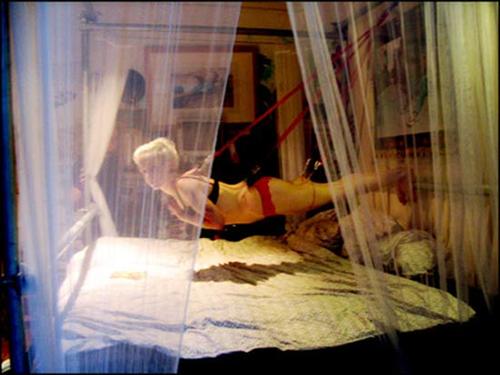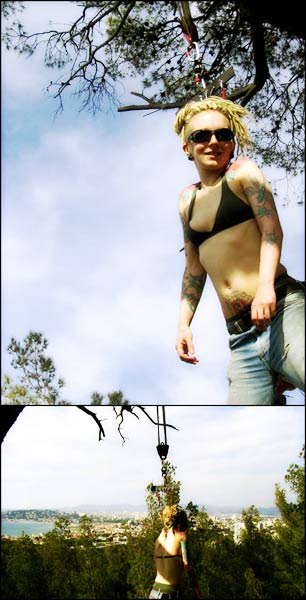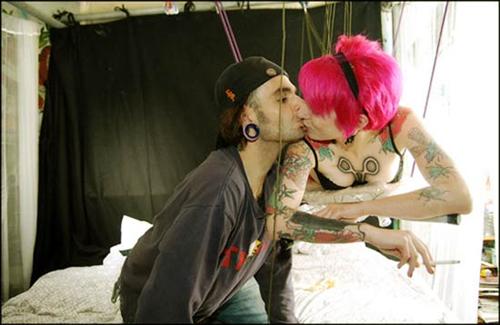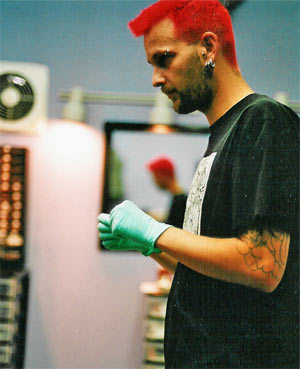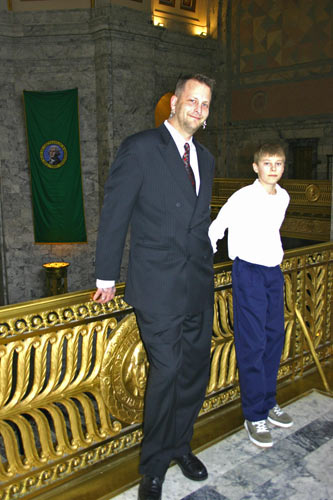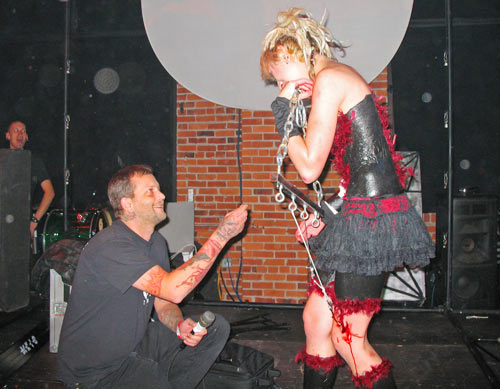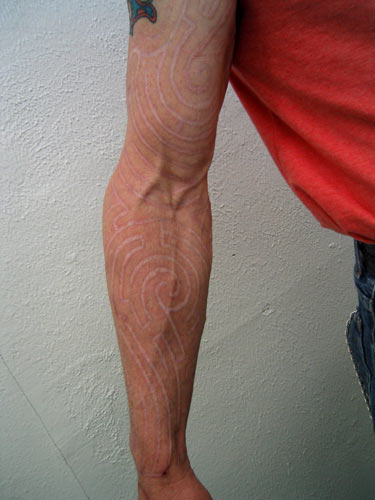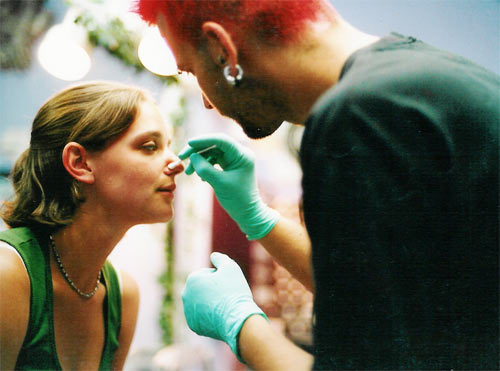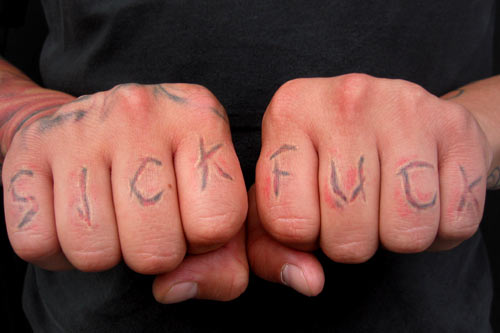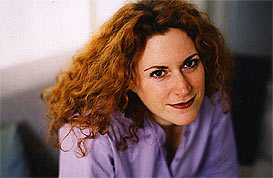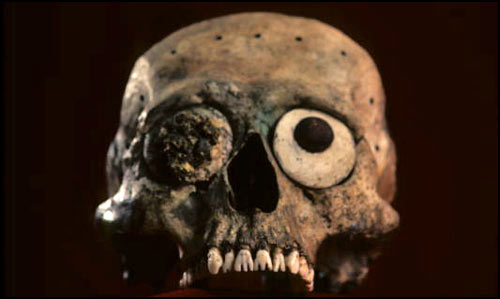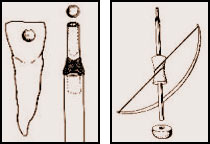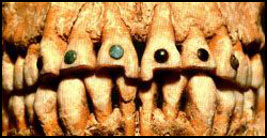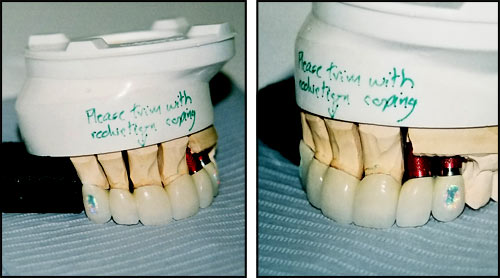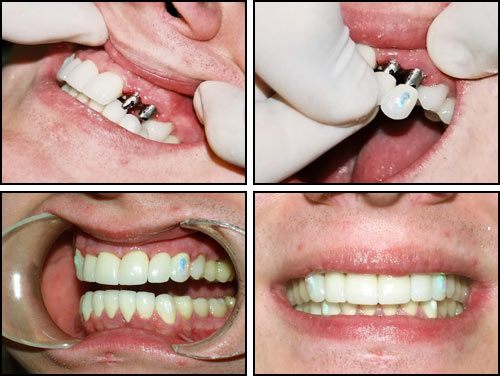|
Habakuk: My nudist and extreme body play friend “Habakuk” lives in the rural Horn of Africa where he is probably the most famous “mzungu” (white guy) in his area for reasons I can’t discuss here — unfortunately large parts of this interview have had to be redacted to protect his identity. But, as with many upstanding and successful individuals, he has many kinky interests that only those closest to him know about. Near his home where he hikes nude — “real old-fashioned African bush the way Livingstone found it… my paradise” — amid game like bushbuck, blue monkeys, baboons, duikers, hyena, and leopards, all harmless to humans, he can exercise, think, and be himself. Among other things, this includes swinging from the trees, held up by nothing but his scrotum.
Habakuk’s experiences with body modification and body play center around the extremes of personal freedom and the extremes of sensation, and the joys that both of those can bring a person. He has a purity of experience in all things that I admire greatly. * * * Shannon: Let’s start by talking about where you grew up. I grew up in Papua New Guinea, between Papuas of the stone age. I was a mission child in an uncontrolled (by government) area that could only be reached by plane, landing against a hilltop. Those people were the most primitive man eaters, and naked except for a tube on their penis. I saw them eating their own chief and I saw tribal wars with poisoned arrows right in front of our house. Excellent body modificators though — but I did not pick up the idea there. Shannon: Were you at all exposed to indigenous modifications? The upcountry Papuas, and to a lesser extent also coastal Papuas, did modifications. Generally they were not sexually oriented, except for the penis gourd. I do not know the exact meaning, but the men started wearing the tubes at puberty, when they were only allowed a short one. Depending on their performance in life and war, they were progressively allowed to wear longer ones. The biggest were for chiefs, and they were sometimes bent to allow them to be bigger. We were the first missionaries who went there, so we knew very little about their sexuality — during my time the first priority was to learn the language.
The women also had a modification which had a sexual meaning that we didn’t understand either… at regular intervals they had one of their fingers chopped short. Of course the other modifications are well known — big earrings, and especially the tusks of swine through the nose. Scarification in patterns was also very common. Shannon: Do you think growing up in Papua New Guinea influenced your own interests at all, even if just the nudism? I have no idea whether New Guinea influenced my desire for nudism or pain. I actually think that it was in my genes from the onset. I cannot eliminate the feeling of clothes, so nudism is all important. I cannot imagine doing a suspension with my clothes on — it just would not work. Of course the sensation concentrates in the play area, but the conditions to enjoy it are set by the whole body. Shannon: Why did you leave New Guinea? We left New Guinea because my fathers contract with the [redacted] Baptist Mission ended. We went to [redacted] and I finished my studies there. Immediately after my studies I looked for a way to escape the draft. I enlisted as a volunteer to work in Tanzania as an engineer, which I did for two years, and then went back to [redacted] where I continued my studies and got married. I was then a member of a Naturist (FKK) society, and made it a condition that my wife would agree to adopt a nudist lifestyle. She agreed, but we eventually divorced three years ago. Shannon: Is that what made you decide to move back to Africa? I moved back because I could not stand the over-regulated, “I don’t care about the rest of the world”, [redacted] society. They think that they enjoy freedom, but do not realize that they live in a straight-jacket of rules and over-regulation. I always say: they can say what they want but not do what they want. This applies to general life, and to sexuality in particular. In the time I left, sexuality and nakedness were no topics for discussion. In many ways Africa provides much more freedom.
Shannon: And your split with your wife? My wife gave up on nudism, and made it difficult for me to practice it. I gave in but eventually of course that created big problems in our marriage. In the beginning she accepted my kinkier interests — only to keep me happy — but she did not like it. She did not want anything to do with masochistic games and modifications. For her it was absolutely crazy, as it was for most “normal” people. It was a part of the reason for the break up of my marriage, which I delayed for fifteen years because of my children. Her jealousy, nagging, lack of any sexual fantasy, and eventually almost total absence of sex were the other reasons. Shannon: What does your current wife think about it? My new wife knows about it, but does not really understand. I have an agreement in the sense that she allows it, but does not want to see it. She says she is mainly scared about permanent damage or other negative effects. I am working on her, but basically my relationship with her is a “normal” one, except that she loves to be naked too. She loves walking in the bush and to shake her little fat backside in front of me, and at home she is usually naked. We met through friends from [redacted] who had more or less adopted her and paid for her school fees. They asked me to look after her when they went home at the end of their contract. I guess I did it a bit too well! I had known her already for five years before things started to develop. In the beginning, we just talked about life. I guess the thing that really made me think about her romantically was the ease with which she took her clothes off when we went for a walk in the [conservation area near where we now live in Africa] together with our friends from [redacted]. Shannon: Do you mind telling me what you now do in Africa? [redacted — sorry, because it’s quite fascinating!] … what keeps me busy right now. I have a small manufacturing company, where we make pumps, windmills, and steel window and door frames. * * * Shannon: Tell me about what you do to relax… As far as I am concerned, to be free in nature is the most important thing in life. I am a fanatic nudist. I love body modification and certain kinds of pain — you know what I mean. I do not think that I would relish the pain of dying of cancer, as I saw my father suffering. Shannon: And your interest in pain is linked to your sexuality? You know that is a horribly difficult question, because I do not know the right answer. As a young boy of seven or eight I had no idea about sex, but I had all these ideas about being tied up, locked up, whipped, and so on. I remember that I made an automatic tie-up machine out of Meccano in my wardrobe. Why is that? Freud probably would have had some fancy explanations, about some youth syndrome or something like that… but they would not fit. I had a most liberal free upbringing. Sure, in those days adults would not tell you about sex, and you had to find out for yourself, but I do not think that gave me any trauma. So why do I — we — want this? I simply do not know. I guess I was just born like that, as you are born with certain other abilities and drives. All I know is that I like it, and that I have outgrown all my guilty feelings about enjoying what I want. Shannon: Did you ever consider as a child what your interests “meant”? When I was a kid playing with myself, I did not have any idea why or what it meant. I did it mostly privately, but not completely. My brother was sometimes involved, and my parents were asking what the hell I was doing in the wardrobe — I did not really hide it at that time. Guilt came later when I discovered sexuality and masturbating. My parents never said anything, but gave me that little church book… You know, about hell and damnation if you touch yourselves. I did not even dare to talk or ask about my desire for sexual pain. I knew that everyone would say it was bad and that I was crazy. * * * Shannon: You don’t have any permanent modifications, correct? I have pierced myself for years, but I cannot have permanent ones yet. My new wife may allow me some in due course but she is scared of these things. I have made a special ring design around the root of the penis going through the skin just above the scrotum and I also have designs for permanent 4mm stainless steel pins — not rings — through the nipples to be connected with a string of beads to the penis rings. Maybe one day… Shannon: But temporary piercings you do perform… I used to pierce my skin with needles. At first I was scared to do more, but when I learned that no harm was done, I grew bolder. I did not use surgical needles because they are too sharp and cut the skin and cause bleeding, and at the same time they do not really hurt. I push homemade needles, up to 4mm in thickness, pointed like a normal pin through the skin slowly. It is much more effective than surgical needles because they do not cut the skin, but open it and spread it. I started using surgical needles when I started not just piercing the skin but going right through the body of the penis, nipples, and scrotum, mainly because I wanted to be sure about sterility. Shannon: How do you make the needles? I make needles out of stainless steel piano wire. It’s very simple — just sharpen the end and bend the other end in a loop. I made the thick needles out of 1/8” brazing rod, as well as hairpins.
Shannon: Is your bed of nails part of the same sort of play? My nail bed fits in the general pattern. The relation between pain and sex is interesting, but not clear to me. If I am very blue, I long for pain, but sometimes after a long session of self-torture I just do not need sex any more. It seems that the pain session has replaced the need for sex. On the other hand, if I do masturbate after a pain session it comes with a vengeance. It also depends on whether you are really relaxed — and whether you used some Dutch courage or not. What is clear is that I prefer the slow build-up of pain. The needles fit this pattern, the suspension does, and the nail bed fits in as well. I can lay on it and feel the pain, fierce in the beginning, then beginning to settle and burn, and eventually it replaces everything else. Shannon: Let’s get to the main thing and talk about your scrotal stretching and play. The scrotal stretching came about a long time ago. I was a boy of maybe seventeen when I tied my balls to a rope and a water pipe in my room and bent over backwards to pull. It was just the need for pain. I had no idea of stretching and scrotal suspension, although it was probably in the back of my mind. After seeing pictures of stretching and suspension on the web, I started experimenting. I started with ropes, then with a wooden block, and finally I made metal rings. I wear this ring permanently. My wife knows and has accepted it, but unfortunately this is a very conservative country, and not much is openly possible. I would love to meet like-minded people and show off! The actual stretching is caused by regular exercise, not by the wearing of the ring — the tendons holding the testicles have developed much more strength. My stretching is now subjected to the law of diminishing profits: At first my balls would stretch 1cm per month. Now it is reduced to 1cm per half year, but they still stretch. In the beginning I used the wooden block with a hole of 32mm (1 ¼”) and it worked well at first but gradually I had swelling problems with it. When I made my first metal ring I had to increase the size slightly since it looks like with exercise the internal tissue thickens when strengthening. Also interesting is that the skin of the sack feels thicker, especially the part that covers the balls outside the ring. When I take the ring off, that skin pulls together and feels leathery, showing that the contracting muscles of the skin of the scrotum have strengthened. I think that this shows the need for exercise, gradually increasing the strain, to build strength. Shannon: When you actually suspend, how do you prepare? I do a warm-up before any pain session. The main issue is to relax, to concentrate on what is going to come. I usually arouse myself sexually, but not always. I may have a gin and tonic, mainly to forget everything else. I may play with my balls and tell them to get ready for suffering. Physically I lubricate the skin with some talcum powder or Vaseline. I usually suspend for as long as I can bear it. At the moment that’s about three minutes, which I repeat two or three times afterwards. I hope however to extend how long I can suspend to fifteen minutes — the problem at this moment is not the balls as such, but my body. The limitation is set by my stomach muscles. It slowly improves, because I am learning to let the body bend over backwards more freely. I can hang straight upside down, which is more relaxing, but the limitation is the blood pressure building up in the head. Shannon: What does it feel like to do a scrotal suspension? When I hang there my mind concentrates totally on controlling the body and the pain. On achievement. Afterwards you feel totally satisfied, relaxed, and tired. Shannon: Have you had any complications? I read with interest about the little incident you had when someone almost lost a testicle [Editor’s note: this is in reference to Roy from “Roy’s Nut Hang” whose scrotum once split open during a suspension and exposed and almost caused the loss of a testicle]. I have had no complications. The reason is, I guess, that I built up slowly. I took my time to build strength. In the beginning I could not even bear 5kg. I carefully experimented with rings and blocks to give the balls sufficient support. The trick is that the ring must be tight, and well shaped. The problem with that is that it restricts the circulation, and the balls start swelling, so you cannot wear such a ring permanently. If the ring is too loose, you can feel that the epididymis is squeezed out under the ring when force is applied. This organ is the one that causes the pain when you are kicked in the balls, and consequently this is very painful, and not a “pleasant” pain. Adjust the size of the ring and now the actual testicles start squeezing out. I solved the problem by making the ring less loose and stuffing it with some foam rubber during a session to keep the epididymis in place. It’s important to listen to the body. After all, the function of pain is to warn the mind to prevent damage to the body. I learned that from Lawrence of Arabia, who said “Pain does not matter and is useful. The trick is to know how much pain will indicate the start of real damage”. Balls are not designed to dangle from, and you have to develop their strength gradually — but it is amazing how fast this happens. Shannon: Does it feel better to do the suspensions outside? The best environment to play in is in the bush in the open air. Obviously most people will do their game inside because they do not have any other place to go. What we do can generally not be done in public… yet. But in my experience, do it outside whenever you can. It is much more relaxing and exciting. The sun and a little wind on the skin enhances the awareness of your body. The most important thing of all is, I think, to feel your body. I think that many people do not “feel” their body. For most it is just there, and they realize that they have a body when someone touches it for sex, but I experience and feel my body and skin all the time. Clothing messes it up, and that is why I do not want it. Prepare naked for whatever you do. The body must be free. Shannon: Does the suspension experience change over time? Yes, the experience does change as time passes. The thing is that in normal life the brain is always busy with something, but when you suspend that is all gone. There is only one thing: the balls with the body hanging from it. Afterwards you lay down — do nothing. Maybe repeat the exercise after a few minutes. Maybe masturbate, but if not, you feel as if you had an orgasm… the same feeling of total satisfaction. As time passed, and the initial fear for damage or injury disappears, I enjoy it more. It is more relaxing. Shannon: Is there a recovery period? There is a short recovery period, allowing the circulation to reestablish. The scrotum is wedged tight in the ring, and you have to pull it back, but after a few minutes you can do it again. * * * Shannon: Can you describe some more what the pain-pleasure experience is like? Just imagine the pain wracking your body, when you are hanging on a rope tied around your balls, and enjoying it! “Absolutely crazy”, so-called normal people will say — when I was a young fellow I worried a lot about that. However, the fact was that I had a much nicer and better orgasm, “helping” myself if I thought of being tortured — my body just begged for it. Naturally I tried it out. I whipped myself. I hung weights on my balls. I tied them hard. I experimented with needles, electricity, you name it. The excitement of just planning something, making my dick as hard as the handle of a hammer, was already a joy, but the kick of the actual pain of a thick needle slowly driven through the foreskin cannot be described. Before you do it, you can already feel the pain of the tip of the needle on the skin, slowly increasing, building up the pressure. The skin breaks, and stretches. You need all your power to drive the needle deeper. The skin on the other side stretches, turns white under the pressure, until the tip of the needle breaks through. You have done it. Then comes the reward of an extreme orgasm… Nuts? Yes, sure, but I have now learned to enjoy being crazy. It took me time to realize that I was made this way, and that I did not create myself. If I have been created enjoying pain like that, well, I better enjoy it. To hell with what the rest of the world may think of it. Shannon: Did you have other worries about what you were doing as well? One thing — “Am I alone?” I wondered how far I could go? I dreamed about driving a needle right through my dick or balls, and I dreamed about hanging by my balls. I dreamed of having permanent needles through my nipples and dick, but the question remained: could this be done without undue risk and danger? What will happen? There was no one to ask, and I had a partner who did everything possible to stop me. Then came the computer, and with that the Internet. It was great discovering BME — after all these fake wishy-washy SM sites, finally something real. There it was: Needles right through the dick. The balls. Nails, cutting, rings, everything. I went right through the whole library. The biggest surprise of all: a guy dangling upside down by the balls, which were stretched out a foot or so. It could be done! I hardly slept, and went to work straight away. But how? I am an engineer, and I know a thing or two about stresses. I realized that just tying a rope around my balls was possible, but the stresses would be born by just a few strands of skin. The skin would be torn easily, and the stress would never be on the same place. I needed something else to distribute the force of my weight evenly over the skin and internal structures of my balls. At first I tied a curtain rope around my balls, which I protected with a piece of cloth in such a way that there was a loop in the rope on each side of the testicles. This distributed the weight quite well. I hung a block and tackle from the ceiling, with a weighing scale in-between, and started exercising. That was tough! In the beginning I just managed to pull with ten pounds or so… This was going to be a long haul! By increasing the force a little bit each day I made progress, and after a month I could bear 30kg for a few seconds. Shannon: What was it like as you started to approach bearing masses equivalent to your body weight, and could actually suspend? The strain on my balls was enormous. Sometimes blood was oozing from the skin, but I came closer and closer to my goal, and finally that big day came when I released my hands from the rope that held up my upper body weight. I was dangling freely with a 12kg weight on my feet, stretched horizontally — 92kg in total. My balls were dark purple and the strain stretched the skin like a drum skin. They looked as if they were polished. The pain was enormous, but that did not prevent my dick’s reaction. The bastard knew what reward would be his! I only managed for a few seconds, but I had succeeded! When I came down I had an orgasm like never before. Guess what? I am not so young anymore, and over the years the volume and strength of my come had been reduced. It would just lie there on my belly, at the end of my dick, but now, after all this exercise, some essential muscles have apparently been strengthened, and I came with a quantity and force as never before! Right up to my face. The days, weeks, and month after, I continued exercising to be able to hang longer, but I also wished to hang without the weight on my feet. This took me another two months, but eventually I was dangling hanging by the balls, with my body leaning backwards. My balls stretch up to 25cm below my crotch or 10cm above the kneecap. I finally replaced the wooden block with a permanent brass and stainless steel ring. It is a beautiful ring with my coat of arms on it. The ring keeps my balls permanently lowered to about 15cm below my crotch. It makes me aware all the time of the presence of my balls, when they dangle between my legs, whether I am dressed or not — usually not! * * * Shannon: You mentioned that you were a missionary child… Do you mind if I ask about your religious views? I do not mind talking about it. As you can understand, I had a Protestant Christian upbringing, but because of where I have been, I have been in touch with many other beliefs. It makes you realize that it is so futile to claim that we Christians are the only correct ones. If I had been born a Muslim I would probably a fanatic Muslim by now. But then there is the question “is there a God?” We have absolutely no proof — it is just a belief. So I decided to die spiritually, and to be born again. I tried consciously to ban all of what I had from my mind, and I started reading — the Bible, yes, but also the Koran. I studied Bahia, Hinduism, and Buddhism. My conclusion? I think that there is more to life than substance. I cannot prove it, but I can sense it, and see it in the way evolution is regulated and used as a laboratory for development. There must be a power which we do not know yet. The rest of religion is crap. What would such a power wish us to do with our lives? Well, the ten commandments are a good start — they just make sense — and it basically repeats in all faiths. And that is where my religion stops. About our nakedness? Well, this big power, God, created us naked, and he saw that it was good. He never told anyone to dress up. Christ, that great prophet, died naked on the cross. It is only some church idiots who insist on always drawing a piece of cloth in front of his dick. I am very curious to find out when I die what the truth is. Shannon: Finally, anything you’d do differently if you could do it all over again? Unfortunately my exploration of my interests comes a bit late, because definitely I would have done things differently if I had been in touch earlier. I am almost sixty, and I am not as randy and strongly masochistic as I was before. It is too late to find a partner with similar ideas. If [BME and greater awareness of this subject] had existed when I was eighteen, my whole life would have been different.
|

